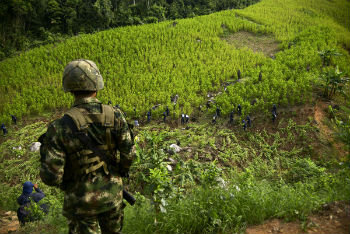Colombia’s first-ever coca substitution program involving rebel group the FARC has the potential to significantly alter the country’s drug trafficking landscape, but there are stumbling blocks that could derail efforts to contain the country’s booming cocaine production.
On June 10, Colombia’s government and the Revolutionary Armed Forces of Colombia (Fuerzas Armadas Revolucionarias de Colombia – FARC) agreed on a voluntary program to replace coca crops in 10 communities surrounding the municipality of Briceño, in the northwestern department of Antioquia. The pilot project is expected to assist some 450 families who currently grow coca transition to alternative crops, such as coffee and passion fruit. The program is scheduled to begin July 10.
 Colombia’s government has implemented coca substitution programs in the past, but this will be the first that involves the FARC, which is believed to control up to 70 percent of the country’s coca crops. The FARC and the government have been engaged in peace negotiations since late 2012. The two sides came to an agreement on illicit drugs in May 2014, which included plans for a crop substitution program.
Colombia’s government has implemented coca substitution programs in the past, but this will be the first that involves the FARC, which is believed to control up to 70 percent of the country’s coca crops. The FARC and the government have been engaged in peace negotiations since late 2012. The two sides came to an agreement on illicit drugs in May 2014, which included plans for a crop substitution program.
SEE ALSO: Coverage of Coca
Iván Márquez, head of the FARC delegation in Havana, Cuba, where the peace talks are taking place, sounded an optimistic note about the pilot program and its chances for expanding to other parts of the country, reported the Miami Herald.
?We can proclaim loudly from Havana that this project — the voluntary substitution program for illicit crops, which is beginning in Colombia — will be a spark that will expand to the four cardinal points,” Márquez said.
This process will be accompanied by the United Nations Office on Drugs and Crime, the International Office for Migration and the UN?s Food and Agriculture Organization, according to El Espectador.
InSight Crime Analysis
The choice of Briceño was a strategic one that gives the government and the FARC a good chance at success. Unlike many other coca-producing areas of the country, in Briceño there is relatively good infrastructure and alternative sources of income. The government is also in the process of constructing the country’s largest hydroelectric dam in Briceño and the near-by municipality of Ituango, which has generated social unrest but has also created jobs and stronger linkages to the wider economy.
The substitution program will also be building on the progress of a FARC-government initiative started last year to remove landmines in the Briceño area. Eduardo Díaz, head of the Colombian government’s efforts to replace illicit crops, told the Miami Herald that the de-mining project helped the two sides work together on the coca issue.
SEE ALSO: FARC News and Profiles
All of these factors bode well for the pilot project set to get underway next month. And Colombia’s peace process is in need of tangible results as it moves closer to a final deal. Among other benefits, concrete examples of success could help sway the opinion of a skeptical public. During field research in over 70 municipalities across the country, InSight Crime found there was very little confidence among locals that a peace accord would result in any substantive changes to their situation.
But Briceño may not be a good bellwether for future coca substitution programs implemented in other parts of the country. Many of the more isolated coca-growing communities do not have viable alternatives for making money, and the government has limited resources to encourage development in these rural areas. It will therefore be much more difficult convincing farmers to switch to crops that are not guaranteed to bring in the same earnings as coca.
Both in Briceño and at the national level, the FARC will play a crucial role in the success or failure of the coca substitution program. Given how much of Colombia’s coca-growing territory is under FARC purview, the rebel group is well-positioned to help slow the explosive growth of cocaine production the country is currently witnessing.
However, there is no guarantee that the FARC will put their full weight behind the agreement. The guerrilla group has been funding its operations in large part by taxing coca production, so encouraging farmers to switch crops would imply a direct hit on the FARC’s bottom line. Even if rebel leadership is preparing for life after a peace deal, there are mid-ranking commanders who would be loath to give up such an important source of income.
Even if the FARC do become active participants in a nationwide coca substitution program, there are other illegal armed groups waiting in the wings to take control of Colombia’s illicit drug production. Briceño, for example, is home to both the FARC and the Urabeños, the most powerful of the country’s neo-paramiliary organizations known as BACRIM (from the Spanish, “bandas criminales”). There are also a plethora of armed groups operating in Catatumbo, Colombia’s principal hub for coca production, all of whom would be keen on appropriating coca-growing territory should the FARC cede control.

